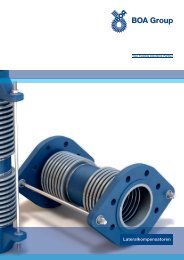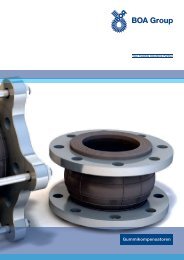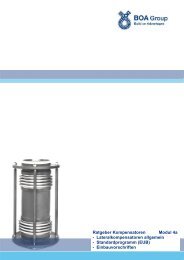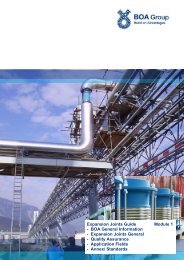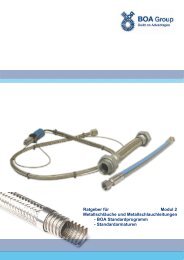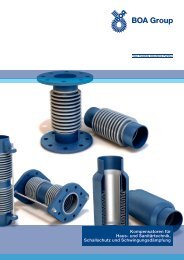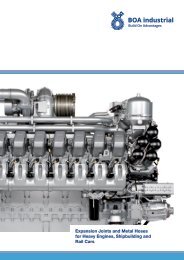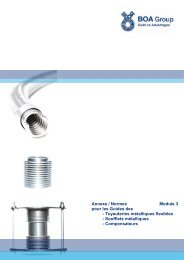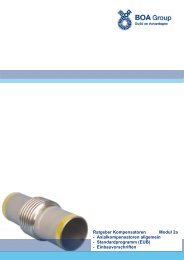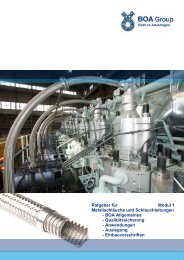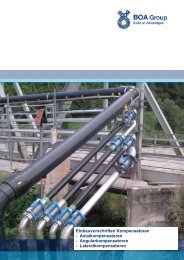Expansion Joint Guide Module 5 - Universal ... - BOA Group
Expansion Joint Guide Module 5 - Universal ... - BOA Group
Expansion Joint Guide Module 5 - Universal ... - BOA Group
- No tags were found...
Create successful ePaper yourself
Turn your PDF publications into a flip-book with our unique Google optimized e-Paper software.
<strong>BOA</strong><br />
<strong>Expansion</strong> <strong>Joint</strong>s <strong>Guide</strong><br />
2 Standard Program <strong>BOA</strong> <strong>Universal</strong> <strong>Expansion</strong> <strong>Joint</strong>s (EFB)<br />
2.1 General<br />
<strong>Expansion</strong> joints manufactured by <strong>BOA</strong> AG Switzerland are formed in the elastomer process (EFB). The core element is the multi-ply metal<br />
bellows (2 to 16 layers) made of austenitic steel. <strong>Expansion</strong> joints produced by this method have a large expansion capacity and are very<br />
flexible. They are especially appropriate to compensate for thermal expansion and minor misalignment during installation. Their advantages<br />
are:<br />
<br />
<br />
<br />
<br />
<br />
<strong>BOA</strong> AG has over 70 years experience in manufacturing expansion joints<br />
multi-ply construction of the bellows, made of high-grade stainless steel (1.4571 and 1.4541), which means high resistance against<br />
ageing, temperature, UV-rays and most of aggressive media.<br />
very low spring rate due to the multi-ply construction of the bellows.<br />
large movements at short construction lengths<br />
due to reasonable stocks, various types in different sizes and pressure ranges are usually available at short time.<br />
Inner sleeve<br />
Inner sleeves protect the bellows and prevent it from being stimulated to oscillate by the fluid. The installation of an inner sleeve is recommended<br />
in the following cases:<br />
abrasive media<br />
large temperature variations<br />
flow rates higher than approx. 8m/s for gaseous media<br />
flow rates higher than approx. 3m/s for liquid media<br />
When installing, the flow direction must be observed!<br />
<strong>Universal</strong> expansion joints usually must absorb large lateral movements /vibrations. Therefore, they are usually used without inner sleeve. An<br />
inner guide sleeve structure allowing large lateral movements inevitably leads to a strong constriction of the flow cross-section. The resulting<br />
local acceleration of the flow medium very often is not accepted. On request (extra charge) inner sleeves may be installed.<br />
Of course expansion joints can be designed and manufactured specifically for other materials, pressure ranges and life cycles.<br />
2.2 Reduction<br />
2.2.1 <strong>Expansion</strong> capacity<br />
NOTE (Hereinafter the term load cycle is used for full load change cycle.)<br />
The maximum permissible expansion capacity is indicated on the expansion joint. It refers to 1000 load cycles (for expansion joints conforming<br />
to EC standards: 500 load cycles with safety factor 2). At higher load cycles, the expansion capacity must be reduced by the load cycle factor<br />
K L according to table 1. For the accurate determination of the load factor K L the following formula can be applied:<br />
K L = (1000 / N adm ) 0.29<br />
Load cycles<br />
N adm<br />
1'000<br />
2'000<br />
3'000<br />
5'000<br />
10'000<br />
30'000<br />
50'000<br />
100'000<br />
200'000<br />
1'000'000<br />
25'000'000<br />
Load cycle factor<br />
K L<br />
1.00<br />
0.82<br />
0.73<br />
0.63<br />
0.51<br />
0.37<br />
0.32<br />
0.26<br />
0.22<br />
0.14<br />
0.05 Table 1<br />
2.2.2 Temperature related movement and pressure reduction<br />
NOTE<br />
The admissible operating pressure is determined by the nominal pressure considering the reduction factor K P according to tab. 2. At higher<br />
temperatures, the expansion capacity K has to be reduced according to the reduction factors.<br />
5



